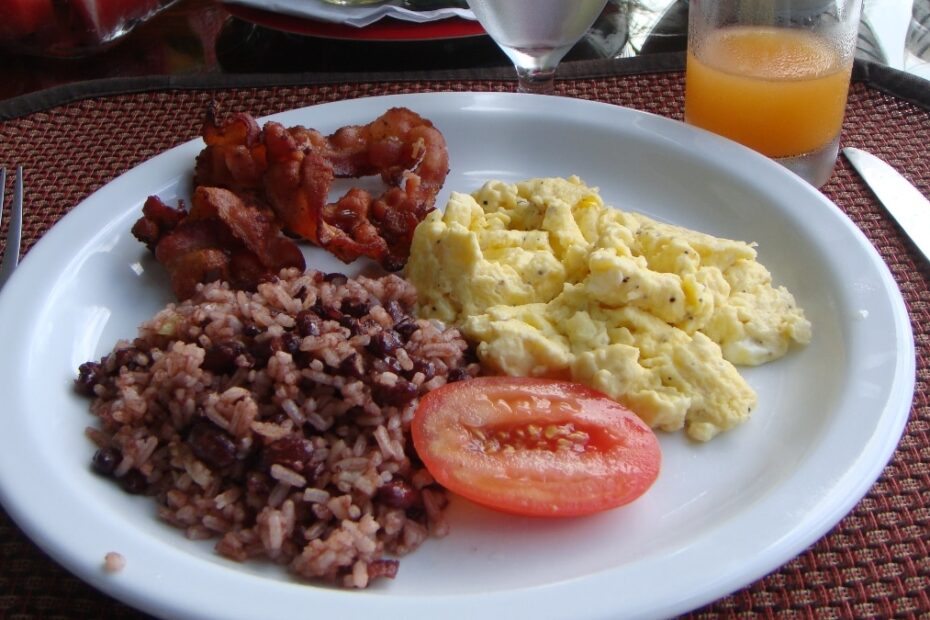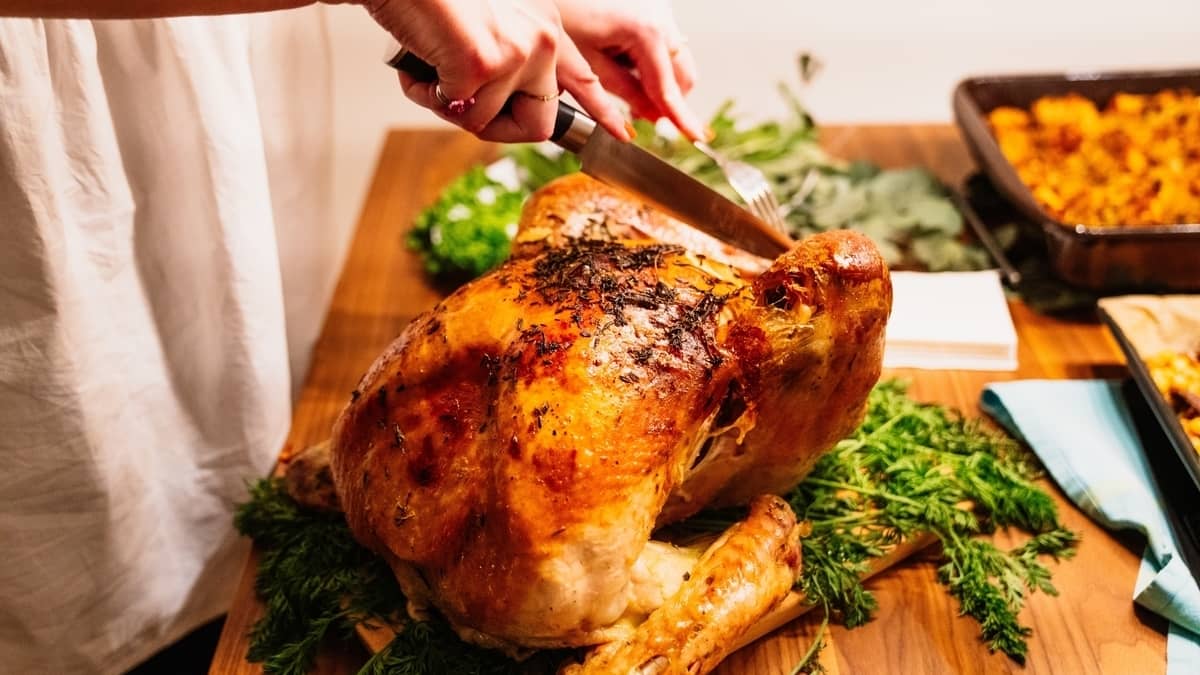Traditional breakfasts in Central America are simple, local, and filling. Beans, rice, eggs, and plantains form the base, but every country does it differently. This article contains links to Amazon, from which, as an Amazon Associate, this website will earn a small commission if you make any purchases. Visit our Affiliate Disclosure Page for more info.
I’ll admit it right now. I’m not actually a breakfast person and it’s been a while since I ate in the morning. I’m all about intermittent fasting (a fancy way of saying “skipping breakfast”) nowadays and I generally don’t eat anything until at least 1:00 PM. It makes sense for me, anyway.
But for many (most?) of you, breakfast is still the most important meal of the day, a feast for champions. I get it and it’s fine. As an Englishman, I miss bacon and eggs with hash browns and sausages in the morning with all my heart. Not very Central American, I know. Not very Costa Rican or Salvadoran, unless you’re staying in a hotel where the breakfast buffet reigns supreme. There, you can go all out on sausages and the rest with pancakes to boot. Or, if you’re curious, it’s worth skipping the buffet for a day to see what locals eat. Every country in Central America has its own traditional breakfast, hearty, flavorful, and deeply rooted in daily life. Here’s a look at what mornings taste like across the region.
Belize
Breakfast in Belize is hearty and comforting. It usually includes fry jacks or johnny cakes, stewed beans, and eggs. Creole bread and coconut-flavored doughs give Belizean breakfasts a distinct character, and coffee is almost always part of the meal. Fruit is common too, especially papaya or banana, which balances the plate without making it too heavy.
What sets Belize apart is the mix of influences that shape its morning table. Creole, Garifuna, and Mestizo traditions all play a role, and each adds something of its own. Fry jacks puff in the oil and split easily to hold beans or eggs, while johnny cakes bake into soft biscuits that go well with cheese or honey. On weekends, meat pies and stew chicken turn up, moving breakfast toward lunch without losing its early-morning feel.
Recipe: Fry Jacks with Stewed Beans
Ingredients
- 2 cups all-purpose flour
- 2 teaspoons baking powder
- 1 teaspoon sugar
- 1 teaspoon salt
- 2 tablespoons shortening or oil
- ¾ cup warm water, plus more if needed
- Oil for frying
- 2 cups cooked red or pinto beans with some cooking liquid
- 1 small onion, chopped
- 1 clove garlic, minced
- Salt and pepper
Instructions
- Mix flour, baking powder, sugar, and salt. Rub in shortening. Add warm water and bring together into a soft dough. Rest 20 minutes.
- Divide into balls, roll into small rounds, and cut each in half.
- Fry in medium-hot oil until puffed and golden. Drain.
- For beans, sauté onion and garlic in a little oil, then add beans and a splash of liquid. Simmer until thick. Season to taste.
- Serve fry jacks with stewed beans and eggs any style.
View this post on Instagram
Costa Rica
Breakfast in Costa Rica is simple, filling, and built around gallo pinto, a mix of rice and black beans cooked with onion and bell pepper. It’s usually served with eggs, fried plantains, and either bread or a corn tortilla. A spoon of natilla, a local sour cream, and a cup of strong coffee complete the meal. Fresh fruit is common too, especially papaya, pineapple, or banana.
The roots of gallo pinto go back to rural kitchens, where leftover rice and beans became the next morning’s breakfast. Every household has its own way of preparing it, though most add Salsa Lizano for flavor. It is food that fits Costa Rica’s pace and climate, easy to make, light enough for the tropics, and always satisfying.
Recipe: Gallo Pinto
Ingredients
- 2 tablespoons oil
- ½ onion, finely chopped
- ½ red bell pepper, finely chopped
- 2 cloves garlic, minced
- 2 cups cooked black beans with a little cooking liquid
- 3 cups cooked white rice (day-old if possible)
- 1 to 2 tablespoons Salsa Lizano, to taste
- 2 tablespoons chopped cilantro
- Salt and pepper
Instructions
- Warm oil in a large pan and cook onion, pepper, and garlic until soft.
- Add beans with a little liquid and simmer briefly.
- Stir in rice and mix well until the beans coat the grains.
- Season with Salsa Lizano, salt, and pepper. Fold in cilantro.
- Serve with eggs, fried plantains, and natilla or sour cream.
View this post on Instagram
El Salvador
Breakfast in El Salvador is built around refried beans, eggs, and fried plantains. The beans are usually smooth and rich, spreadable enough for tortillas or bread. Eggs are either fried or scrambled, and a portion of queso fresco and a spoon of crema are served on the side. Coffee is strong and often sweetened. Avocado or a slice of sausage or ham might appear, especially on weekends.
It’s a balanced, familiar meal that reflects how Salvadorans like to start the day. Simple food made with care and a few well-matched ingredients. Corn tortillas are key, since they tie everything together. Many people also eat pupusas or tamales for breakfast, especially when bought from street vendors or markets. Whatever the variation, the base of beans, eggs, and corn never changes.
Recipe: Desayuno Salvadoreño
Ingredients
- 1 cup refried beans
- 4 eggs
- 1 ripe plantain, sliced
- ½ cup queso fresco, crumbled or sliced
- ½ cup crema
- 8 small corn tortillas or slices of bread
- Oil, salt, and pepper
Instructions
- Fry the plantain slices in a little oil until browned and tender. Keep warm.
- Warm the refried beans over low heat.
- Cook eggs to preference and season with salt and pepper.
- Heat tortillas or bread.
- Serve eggs, beans, plantains, tortillas, queso fresco, and crema. Add avocado or sausage if you like.
View this post on Instagram
Guatemala
Breakfast in Guatemala, known as Desayuno Chapín, is one of the most recognizable meals in the country. It typically includes refried black beans, eggs, fried plantains, queso fresco, crema, and warm corn tortillas. Many people add a quick tomato and onion salsa or a slice of avocado. Coffee is almost always part of the meal, and it is often locally grown and strong.
This is a breakfast that suits Guatemala’s mix of tradition and practicality. It combines the key ingredients found throughout the region but keeps a clear national identity through the use of black beans and the local cheese. The name Chapín itself is an affectionate term for Guatemalans, which makes the breakfast a small symbol of national pride.
Recipe: Desayuno Chapín
Ingredients
- 1 cup refried black beans
- 4 eggs
- 1 cup fried plantain slices
- ½ cup queso fresco
- ½ cup crema
- 8 small corn tortillas
- 1 small tomato and ¼ onion, finely diced
- Pinch of salt and lime juice
Instructions
- Warm beans and keep them thick enough to spread.
- Mix tomato, onion, salt, and lime juice to make a simple salsa.
- Cook eggs to preference.
- Heat tortillas on a dry pan.
- Serve eggs with beans, plantains, tortillas, queso fresco, crema, and the fresh salsa.
View this post on Instagram
Honduras
A traditional breakfast in Honduras is called desayuno típico, and it is one of the most complete morning meals in Central America. It includes eggs, refried beans, fried ripe plantains, queso seco, crema, corn tortillas, and a cup of strong coffee. Avocado slices are common, and some people add a small serving of rice or sausage. Each part of the meal complements the other, making it filling without being heavy.
Hondurans also enjoy baleadas in the morning. This is a warm flour tortilla folded over mashed beans and crema, with optional additions like cheese, egg, or avocado. They are easy to find at small food stalls and are considered one of the country’s most popular quick breakfasts. Whether you sit down for the full plate or grab a baleada to go, breakfast in Honduras is consistent, hearty, and distinctly local.
Recipe: Desayuno Típico Hondureño
Ingredients
- 1 cup refried beans
- 4 eggs
- 1 ripe plantain, sliced
- ½ cup queso seco, sliced
- ½ cup crema
- 8 corn tortillas
- 1 avocado, sliced
- Oil, salt, and pepper
Instructions
- Fry plantain slices in oil until browned and tender. Keep warm.
- Warm the refried beans in a small pot.
- Cook eggs to preference and season with salt and pepper.
- Heat tortillas on a dry pan.
- Serve eggs, beans, plantains, tortillas, queso seco, crema, and avocado.
View this post on Instagram
Nicaragua
Breakfast in Nicaragua centers on gallo pinto, a mix of rice and red beans cooked with onion, bell pepper, and a touch of oil. The red beans give the dish a flavor and color that sets it apart from Costa Rica’s version. It is served with eggs, fried sweet plantains, cuajada or fresh cheese, and warm corn tortillas. Coffee is strong and usually sweetened, and avocado often appears on the side.
The meal is simple, easy to prepare, and full of local ingredients that are always on hand. Gallo pinto is eaten daily in most households and is considered one of the country’s defining dishes. Whether you prefer Costa Rican or Nicaraguan gallo pinto is entirely up to you!
Recipe: Gallo Pinto
Ingredients
- 2 tablespoons oil
- 1 onion, finely chopped
- ½ red bell pepper, finely chopped
- 2 cloves garlic, minced
- 2½ cups cooked small red beans with a little liquid
- 3 cups cooked white rice
- ½ teaspoon ground cumin
- 2 tablespoons chopped cilantro
- Salt and pepper
Instructions
- Sauté onion, pepper, and garlic in oil until soft.
- Add beans with a little liquid and simmer for one minute.
- Stir in rice and mix well.
- Season with cumin, salt, and pepper, then fold in cilantro.
- Serve with eggs, fried plantains, tortillas, and cuajada or fresh cheese.
View this post on Instagram
Panama
Breakfast in Panama often focuses on corn. Thick corn tortillas, torrejitas made from fresh corn, and bollos wrapped and steamed are common choices. Another favorite is hojaldres, a simple fried dough that can be eaten plain, sprinkled with sugar, or served with something savory. Coffee is served everywhere, usually strong and black. Many Panamanians also drink chicha, a homemade fruit juice, in the morning.
In both rural and urban areas, breakfast can include meat such as beef steak, liver, or sausage cooked in a tomato-based stew. The mix of corn and meat reflects Panama’s blend of indigenous, African, and Spanish traditions. Each region has its own take, but the ingredients remain straightforward and familiar, forming a meal that is both practical and deeply rooted in local food culture.
Recipe: Hojaldres con Salchichas Guisadas
Ingredients for hojaldres
- 2 cups flour
- 2 teaspoons baking powder
- 2 teaspoons sugar
- 1 teaspoon salt
- 1 tablespoon oil
- ½ cup water, plus more as needed
- Oil for frying
Ingredients for sausage stew
- 5 or 6 sausages, sliced
- 1 small onion, chopped
- ½ red bell pepper, diced
- 1 small tomato, chopped
- 3 tablespoons tomato paste
- Salt and pepper
Instructions
- Mix flour, baking powder, sugar, and salt. Add oil and water, knead briefly, and rest for one hour.
- Sauté onion, pepper, and tomato. Add sausage and tomato paste, then simmer until the mixture thickens. Season to taste.
- Divide the dough, flatten into discs, and fry in medium-hot oil until golden and puffed.
- Serve the hojaldres with the sausage stew.
View this post on Instagram
What Central American Breakfasts Have in Common
Looking at the breakfasts above, you might see some similarities going on. Not really surprising given how small these seven countries are and the common heritages they share. Most, for example, include some mix of beans, rice, eggs, plantains, tortillas, and coffee. These are everyday ingredients that reflect the region’s agriculture and climate. The combinations differ by country, but the structure stays pretty much the same.
Costa Rica and Nicaragua both serve gallo pinto with small local variations. In Guatemala, El Salvador, and Honduras, refried beans, cheese, and cream play the same role. Belize and Panama (the two Central American outliers, culturally-speaking) move away from rice and beans, focusing more on breads, doughs, and corn-based dishes.
In every country, the traditional breakfast is built around simple, local foods prepared in familiar ways. And wherever you are, each of these breakfasts tells the same story in its own way. Local ingredients, practical cooking, and a routine that has changed very little over time. So when you get up tomorrow and head down to the buffet bar, how about skipping it for something more local? You might well fall in love with a different style of eating!




